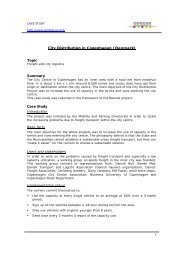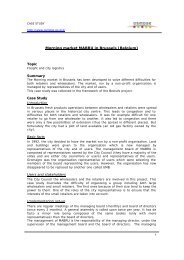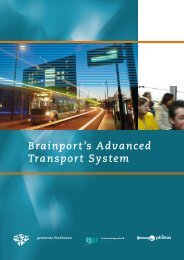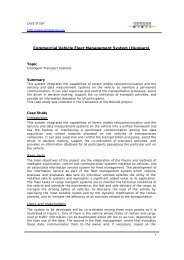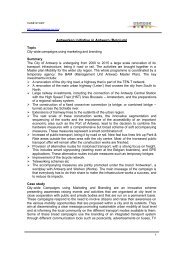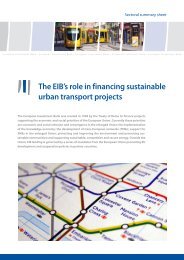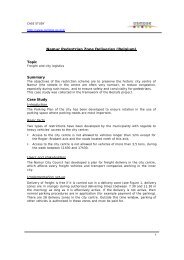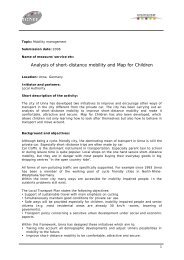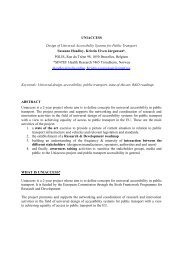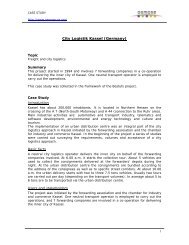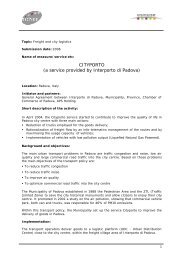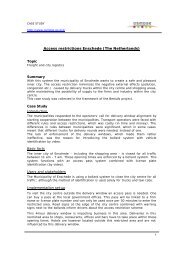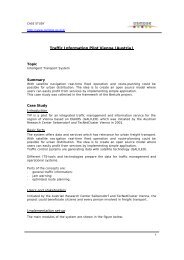- Page 1 and 2: Successful transport decision-makin
- Page 3 and 4: Navigating through the CD - general
- Page 5 and 6: Navigating through Volume 2 Next B
- Page 7 and 8: Table of contents - CD next page Vo
- Page 9 and 10: Successful transport decision-makin
- Page 11 and 12: Table of contents - Volume 1 Concep
- Page 13 and 14: Vol 1 - Table of Contents Next 3
- Page 15 and 16: Vol 1 - Table of Contents Next 5
- Page 17 and 18: Vol 1 - Table of Contents Next 7
- Page 19 and 20: Vol 1 - Table of Contents Next Se
- Page 21 and 22: Vol 1 - Table of Contents Next Ma
- Page 23 and 24: Vol 1 - Table of Contents Next DI
- Page 25 and 26: Vol 1 - Table of Contents Stages i
- Page 27 and 28: Vol 1 - Table of Contents Next (2
- Page 29 and 30: Contextual barriers Vol 1 - Table o
- Page 31 and 32: Vol 1 - Table of Contents Next Ov
- Page 33 and 34: Vol 1 - Table of Contents Next (i
- Page 35 and 36: Vol 1 - Table of Contents Next Ti
- Page 37 and 38: Vol 1 - Table of Contents Planning
- Page 39 and 40: Vol 1 - Table of Contents How to e
- Page 41 and 42: Vol 1 - Table of Contents Next RE
- Page 43 and 44: Vol 1 - Table of Contents Next VI
- Page 45: Vol 1 - Table of Contents Next Se
- Page 49 and 50: Vol 1 - Table of Contents Next Se
- Page 51 and 52: Vol 1 - Table of Contents Next De
- Page 53 and 54: Vol 1 - Table of Contents Next Wh
- Page 55 and 56: Vol 1 - Table of Contents Next Po
- Page 57 and 58: Vol 1 - Table of Contents Next Pr
- Page 59 and 60: Vol 1 - Table of Contents Next Fe
- Page 61 and 62: Vol 1 - Table of Contents Next In
- Page 63 and 64: Vol 1 - Table of Contents Next Po
- Page 65 and 66: Vol 1 - Table of Contents Next Po
- Page 67 and 68: Vol 1 - Table of Contents Next CO
- Page 69 and 70: Vol 1 - Table of Contents Next Ke
- Page 71 and 72: Vol 1 - Table of Contents Next Po
- Page 73 and 74: Vol 1 - Table of Contents Next To
- Page 75 and 76: FS38: Letter FS39: Posters, notices
- Page 77 and 78: Vol 1 - Table of Contents Next Ch
- Page 79 and 80: Vol 1 - Table of Contents Next TE
- Page 81 and 82: Vol 1 - Table of Contents Next Wh
- Page 83 and 84: Vol 1 - Table of Contents Question
- Page 85 and 86: Vol 1 - Table of Contents Next Ex
- Page 87 and 88: Vol 1 - Table of Contents Next Co
- Page 89 and 90: Vol 1 - Table of Contents Next St
- Page 91 and 92: Vol 1 - Table of Contents Next Et
- Page 93 and 94: Vol 1 - Table of Contents Next Se
- Page 95 and 96: Vol 1 - Table of Contents Next Ex
- Page 97 and 98:
Vol 1 - Table of Contents Next Pr
- Page 99 and 100:
Bibliography Vol 1 - Table of Conte
- Page 101 and 102:
Vol 1 - Table of Contents Next De
- Page 103 and 104:
Vol 1 - Table of Contents Next La
- Page 105 and 106:
Vol 1 - Table of Contents Next Se
- Page 107 and 108:
Vol 1 - Table of Contents Next No
- Page 109 and 110:
The following University and resear
- Page 111 and 112:
Successful transport decision-makin
- Page 113 and 114:
Table of contents - Volume 2 fact s
- Page 115 and 116:
Vol 2 - Table of Contents Next An
- Page 117 and 118:
Vol 2 - Table of Contents Next Pr
- Page 119 and 120:
Vol 2 - Table of Contents Designin
- Page 121 and 122:
Vol 2 - Table of Contents Next Or
- Page 123 and 124:
Vol 2 - Table of Contents Next Pr
- Page 125 and 126:
Vol 2 - Table of Contents Next E
- Page 127 and 128:
Vol 2 - Table of Contents Responsi
- Page 129 and 130:
Vol 2 - Table of Contents Next Sk
- Page 131 and 132:
Vol 2 - Table of Contents Next Tr
- Page 133 and 134:
Vol 2 - Table of Contents Next Pr
- Page 135 and 136:
Vol 2 - Table of Contents Next Ti
- Page 137 and 138:
T3 Vol 2 - Table of Contents Next
- Page 139 and 140:
Vol 2 - Table of Contents Next Pr
- Page 141 and 142:
Vol 2 - Table of Contents Assessin
- Page 143 and 144:
Vol 2 - Table of Contents Next Ho
- Page 145 and 146:
Practical information Who is respon
- Page 147 and 148:
Vol 2 - Table of Contents Next Pr
- Page 149 and 150:
Vol 2 - Table of Contents Date Put
- Page 151 and 152:
Vol 2 - Table of Contents Designin
- Page 153 and 154:
Vol 2 - Table of Contents Next Ch
- Page 155 and 156:
Vol 2 - Table of Contents Next Pr
- Page 157 and 158:
Vol 2 - Table of Contents Next Pr
- Page 159 and 160:
Vol 2 - Table of Contents Next Pr
- Page 161 and 162:
Vol 2 - Table of Contents Next De
- Page 163 and 164:
Vol 2 - Table of Contents Next Fo
- Page 165 and 166:
Vol 2 - Table of Contents Next En
- Page 167 and 168:
Vol 2 - Table of Contents Next Pr
- Page 169 and 170:
Vol 2 - Table of Contents Next Sk
- Page 171 and 172:
Vol 2 - Table of Contents Next Id
- Page 173 and 174:
Vol 2 - Table of Contents Next Pr
- Page 175 and 176:
Vol 2 - Table of Contents Next Ho
- Page 177 and 178:
Vol 2 - Table of Contents Next Pr
- Page 179 and 180:
Vol 2 - Table of Contents Overcomi
- Page 181 and 182:
Vol 2 - Table of Contents Next Pr
- Page 183 and 184:
Vol 2 - Table of Contents Next Pr
- Page 185 and 186:
Vol 2 - Table of Contents Next Pr
- Page 187 and 188:
Vol 2 - Table of Contents Next Pr
- Page 189 and 190:
Vol 2 - Table of Contents A model
- Page 191 and 192:
Vol 2 - Table of Contents Distribu
- Page 193 and 194:
Vol 2 - Table of Contents Next En
- Page 195 and 196:
Vol 2 - Table of Contents Next Pr
- Page 197 and 198:
Vol 2 - Table of Contents Next Pr
- Page 199 and 200:
Pour répondre aux nouveaux besoins
- Page 201 and 202:
Vol 2 - Table of Contents Next Pr
- Page 203 and 204:
Vol 2 - Table of Contents Title Yo
- Page 205 and 206:
Vol 2 - Table of Contents Next Pr
- Page 207 and 208:
Vol 2 - Table of Contents Next Il
- Page 209 and 210:
Vol 2 - Table of Contents Next Pa
- Page 211 and 212:
Vol 2 - Table of Contents How do y
- Page 213 and 214:
Vol 2 - Table of Contents Next Pr
- Page 215 and 216:
Vol 2 - Table of Contents Next De
- Page 217 and 218:
Vol 2 - Table of Contents Next Pr
- Page 219 and 220:
Vol 2 - Table of Contents Planning
- Page 221 and 222:
Vol 2 - Table of Contents Planning
- Page 223 and 224:
Vol 2 - Table of Contents Next Pr
- Page 225 and 226:
Vol 2 - Table of Contents Next Pr
- Page 227 and 228:
Vol 2 - Table of Contents Next Pr
- Page 229 and 230:
Vol 2 - Table of Contents Next Pr
- Page 231 and 232:
Vol 2 - Table of Contents Next Pr
- Page 233 and 234:
Vol 2 - Table of Contents Steps to
- Page 235 and 236:
Vol 2 - Table of Contents Next Pr
- Page 237 and 238:
Vol 2 - Table of Contents Next Pr
- Page 239 and 240:
Vol 2 - Table of Contents Next Pr
- Page 241 and 242:
Vol 2 - Table of Contents Next T
- Page 243 and 244:
Vol 2 - Table of Contents Next Pr
- Page 245 and 246:
Vol 2 - Table of Contents Next Pr
- Page 247 and 248:
Vol 2 - Table of Contents How it w
- Page 249 and 250:
Vol 2 - Table of Contents Next 13
- Page 251 and 252:
Vol 2 - Table of Contents Solving
- Page 253 and 254:
Vol 2 - Table of Contents Next Pr
- Page 255 and 256:
Vol 2 - Table of Contents Next Pr
- Page 257 and 258:
Vol 2 - Table of Contents Next En
- Page 259 and 260:
The following University and resear
- Page 261 and 262:
In managing the tramline re-routing
- Page 263 and 264:
Vol 1 - Vol 2 - Decision-making p
- Page 265 and 266:
Vol 1 - Vol 2 - Next Key lessons
- Page 267 and 268:
Decision-making process In February
- Page 269 and 270:
Vol 1 - Vol 2 - Next Key lessons
- Page 271 and 272:
Vol 1 - Vol 2 - Next Timeline ST
- Page 273 and 274:
Vol 1 - Vol 2 - Next Key lessons
- Page 275 and 276:
Vol 1 - Vol 2 - Next Timeline ST
- Page 277 and 278:
Vol 1 - Vol 2 - Next Key lessons
- Page 279 and 280:
Vol 1 - ! Vol 2 - ! " Next STRATEGI
- Page 281 and 282:
Vol 1 - Vol 2 - Next Timeline ST
- Page 283 and 284:
Vol 1 - Vol 2 - Next Key lessons
- Page 285 and 286:
Vol 1 - ! Vol 2 - ! " Next STRATEGI
- Page 287 and 288:
Vol 1 - Vol 2 - Next Timeline MA
- Page 289 and 290:
Vol 1 - Vol 2 - Next Key lessons
- Page 291 and 292:
Vol 1 - Vol 2 - Next Timeline MA
- Page 293 and 294:
Vol 1 - Vol 2 - Next Key lessons
- Page 295 and 296:
Vol 1 - Vol 2 - Next Timeline MA
- Page 297 and 298:
Vol 1 - Vol 2 - Next Key lessons
- Page 299 and 300:
Vol 1 - Vol 2 - Next MAJOR INFRA
- Page 301 and 302:
Vol 1 - Vol 2 - Next MAJOR INFRA
- Page 303 and 304:
Vol 1 - Vol 2 - Next Timeline MA
- Page 305 and 306:
Vol 1 - Vol 2 - Next Key lessons
- Page 307 and 308:
Vol 1 - Vol 2 - Next MAJOR INFRA
- Page 309 and 310:
Vol 1 - Vol 2 - Next MAJOR INFRA
- Page 311 and 312:
Vol 1 - Vol 2 - Next MAJOR INFRA
- Page 313 and 314:
Vol 1 - Vol 2 - Next MAJOR INFRA
- Page 315 and 316:
Vol 1 - Vol 2 - Next MAJOR INFRA
- Page 317 and 318:
Vol 1 - Vol 2 - Next MAJOR INFRA
- Page 319 and 320:
Vol 1 - Vol 2 - Next MAJOR INFRA
- Page 321 and 322:
Vol 1 - Vol 2 - Next TRAVEL DEMA
- Page 323 and 324:
Vol 1 - Vol 2 - Next Key lessons
- Page 325 and 326:
Vol 1 - Vol 2 - Next TRAVEL DEMA
- Page 327 and 328:
Vol 1 - Vol 2 - Next Key lessons
- Page 329 and 330:
Vol 1 - Vol 2 - Next TRAVEL DEMA
- Page 331 and 332:
Vol 1 - Vol 2 - Next Key lessons
- Page 333 and 334:
Vol 1 - Vol 2 - Next NEIGHBOURHO
- Page 335 and 336:
Vol 1 - Vol 2 - Next NEIGHBOURHO
- Page 337 and 338:
Vol 1 - Vol 2 - Next NEIGHBOURHO
- Page 339:
Vol 1 - Vol 2 - Next Key lessons



